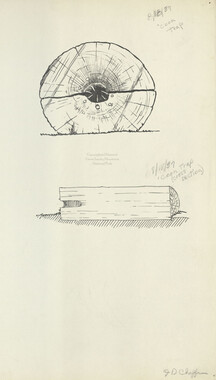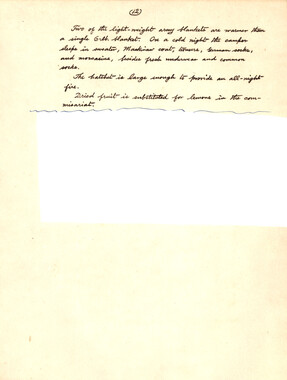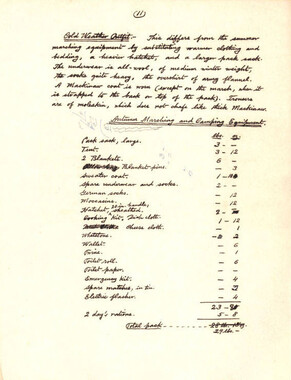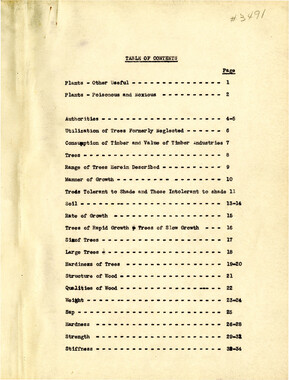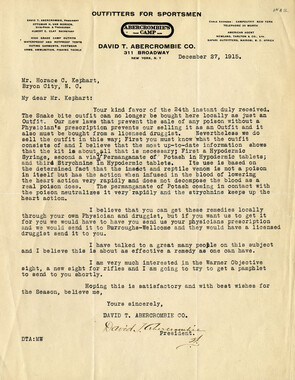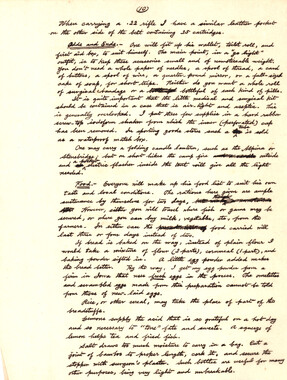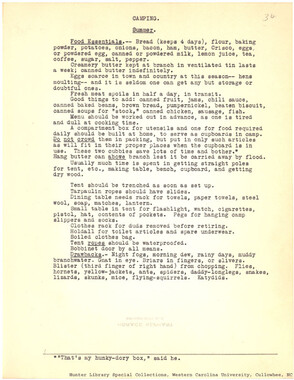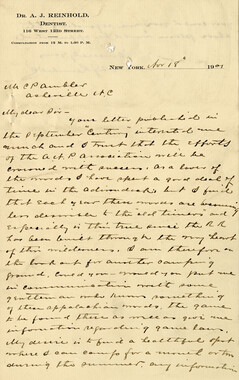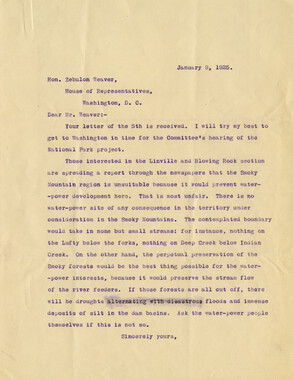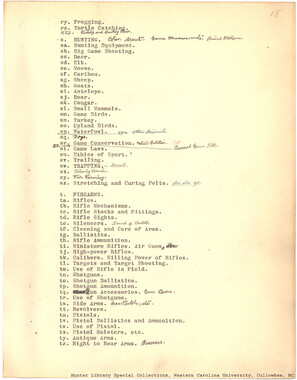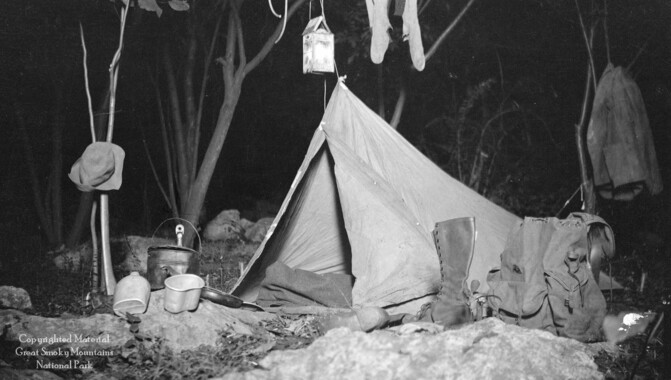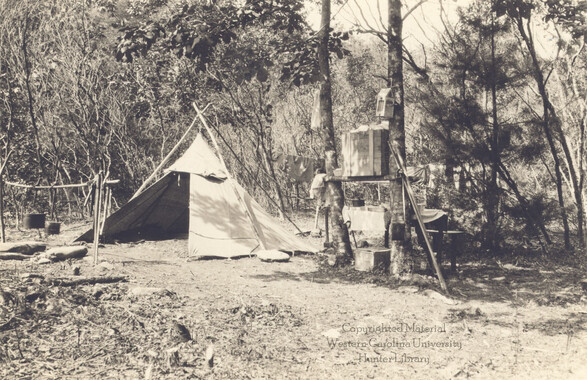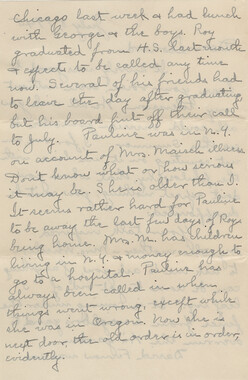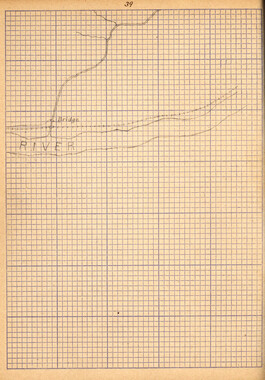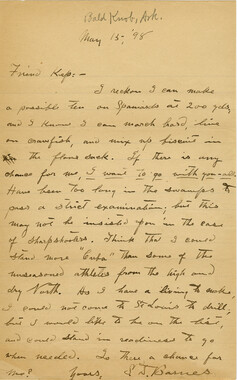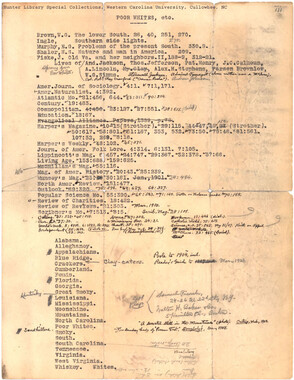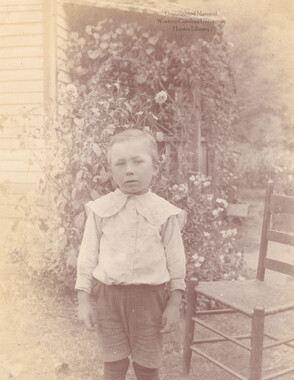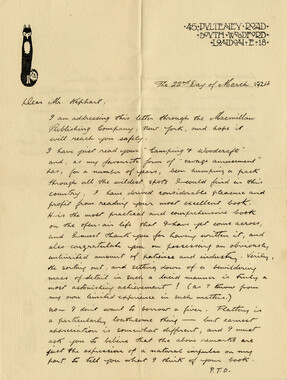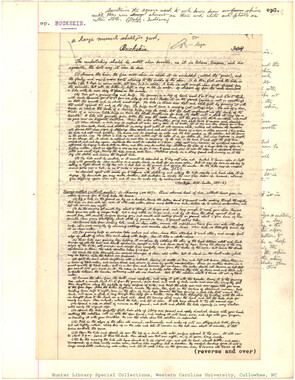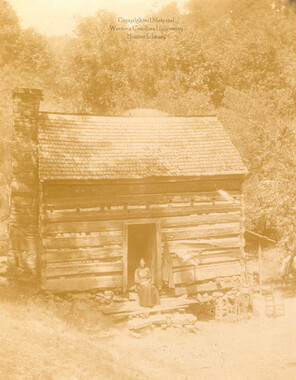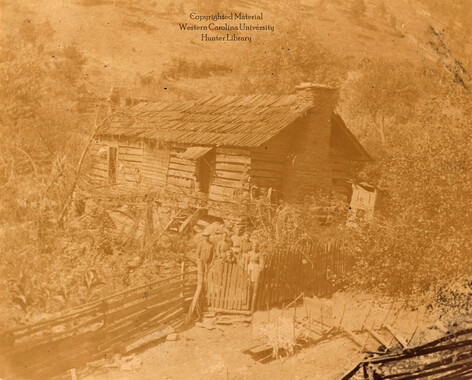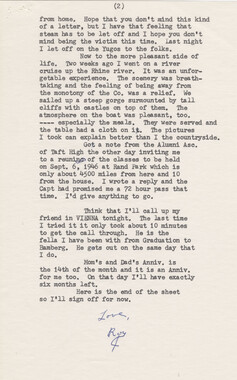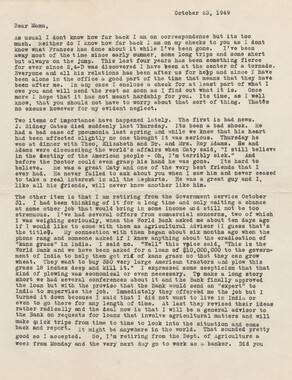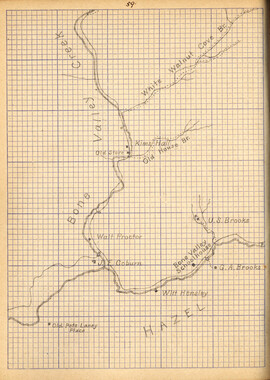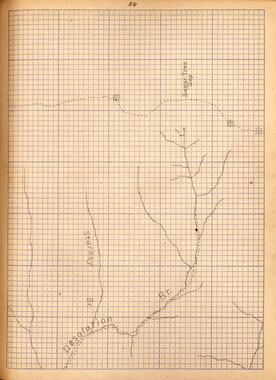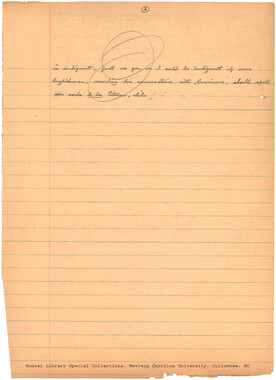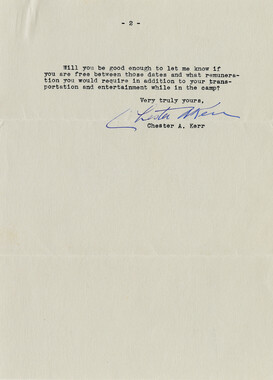Western Carolina University (20)
View all
- Canton Champion Fibre Company (2308)
- Cherokee Traditions (291)
- Civil War in Southern Appalachia (165)
- Craft Revival (1942)
- Great Smoky Mountains - A Park for America (2946)
- Highlights from Western Carolina University (430)
- Horace Kephart (941)
- Journeys Through Jackson (159)
- LGBTQIA+ Archive of Jackson County (85)
- Oral Histories of Western North Carolina (314)
- Picturing Appalachia (6798)
- Stories of Mountain Folk (413)
- Travel Western North Carolina (160)
- Western Carolina University Fine Art Museum Vitreograph Collection (129)
- Western Carolina University Herbarium (92)
- Western Carolina University: Making Memories (708)
- Western Carolina University Publications (2412)
- Western Carolina University Restricted Electronic Theses and Dissertations (146)
- Western North Carolina Regional Maps (71)
- World War II in Southern Appalachia (131)
University of North Carolina Asheville (6)
View all
- Kephart, Calvin, 1883-1969 (15)
- Kephart, Horace, 1862-1931 (290)
- Kephart, Laura, 1862-1954 (39)
- Masa, George, 1881-1933 (1)
- Thompson, James Edward, 1880-1976 (1)
- Weaver, Zebulon, 1872-1948 (3)
- Allanstand Cottage Industries (0)
- Appalachian National Park Association (0)
- Bennett, Kelly, 1890-1974 (0)
- Berry, Walter (0)
- Brasstown Carvers (0)
- Cain, Doreyl Ammons (0)
- Carver, George Washington, 1864?-1943 (0)
- Cathey, Joseph, 1803-1874 (0)
- Champion Fibre Company (0)
- Champion Paper and Fibre Company (0)
- Cherokee Indian Fair Association (0)
- Cherokee Language Program (0)
- Crittenden, Lorraine (0)
- Crowe, Amanda (0)
- Edmonston, Thomas Benton, 1842-1907 (0)
- Ensley, A. L. (Abraham Lincoln), 1865-1948 (0)
- Fromer, Irving Rhodes, 1913-1994 (0)
- George Butz (BFS 1907) (0)
- Goodrich, Frances Louisa (0)
- Grant, George Alexander, 1891-1964 (0)
- Heard, Marian Gladys (0)
- Laney, Gideon Thomas, 1889-1976 (0)
- McElhinney, William Julian, 1896-1953 (0)
- Niggli, Josephina, 1910-1983 (0)
- North Carolina Park Commission (0)
- Osborne, Kezia Stradley (0)
- Owens, Samuel Robert, 1918-1995 (0)
- Penland Weavers and Potters (0)
- Rhodes, Judy (0)
- Roberts, Vivienne (0)
- Roth, Albert, 1890-1974 (0)
- Schenck, Carl Alwin, 1868-1955 (0)
- Sherrill's Photography Studio (0)
- Smith, Edward Clark (0)
- Southern Highland Handicraft Guild (0)
- Southern Highlanders, Inc. (0)
- Stalcup, Jesse Bryson (0)
- Stearns, I. K. (0)
- United States. Indian Arts and Crafts Board (0)
- USFS (0)
- Vance, Zebulon Baird, 1830-1894 (0)
- Western Carolina College (0)
- Western Carolina Teachers College (0)
- Western Carolina University (0)
- Western Carolina University. Mountain Heritage Center (0)
- Whitman, Walt, 1819-1892 (0)
- Wilburn, Hiram Coleman, 1880-1967 (0)
- Williams, Isadora (0)
- 1880s (10)
- 1890s (29)
- 1900s (8)
- 1910s (138)
- 1920s (219)
- 1930s (33)
- 1940s (35)
- 1950s (15)
- 1600s (0)
- 1700s (0)
- 1800s (0)
- 1810s (0)
- 1820s (0)
- 1830s (0)
- 1840s (0)
- 1850s (0)
- 1860s (0)
- 1870s (0)
- 1960s (0)
- 1970s (0)
- 1980s (0)
- 1990s (0)
- 2000s (0)
- 2010s (0)
- 2020s (0)
- Appalachian Region, Southern (69)
- Blount County (Tenn.) (1)
- Buncombe County (N.C.) (5)
- Henderson County (N.C.) (1)
- Jackson County (N.C.) (6)
- Knox County (Tenn.) (2)
- Knoxville (Tenn.) (1)
- Macon County (N.C.) (1)
- Mitchell County (N.C.) (2)
- Qualla Boundary (1)
- Swain County (N.C.) (88)
- Asheville (N.C.) (0)
- Avery County (N.C.) (0)
- Cherokee County (N.C.) (0)
- Clay County (N.C.) (0)
- Graham County (N.C.) (0)
- Great Smoky Mountains National Park (N.C. and Tenn.) (0)
- Haywood County (N.C.) (0)
- Lake Santeetlah (N.C.) (0)
- Madison County (N.C.) (0)
- McDowell County (N.C.) (0)
- Polk County (N.C.) (0)
- Rutherford County (N.C.) (0)
- Transylvania County (N.C.) (0)
- Watauga County (N.C.) (0)
- Waynesville (N.C.) (0)
- Yancey County (N.C.) (0)
- Artifacts (object Genre) (85)
- Clippings (information Artifacts) (15)
- Envelopes (37)
- Glass Plate Negatives (5)
- Letters (correspondence) (366)
- Manuscripts (documents) (273)
- Maps (documents) (3)
- Memorandums (1)
- Photographs (195)
- Portraits (8)
- Postcards (5)
- Publications (documents) (6)
- Aerial Photographs (0)
- Aerial Views (0)
- Albums (books) (0)
- Articles (0)
- Bibliographies (0)
- Biography (general Genre) (0)
- Cards (information Artifacts) (0)
- Copybooks (instructional Materials) (0)
- Crafts (art Genres) (0)
- Depictions (visual Works) (0)
- Design Drawings (0)
- Drawings (visual Works) (0)
- Exhibitions (events) (0)
- Facsimiles (reproductions) (0)
- Fiction (general Genre) (0)
- Financial Records (0)
- Fliers (printed Matter) (0)
- Guidebooks (0)
- Internegatives (0)
- Interviews (0)
- Land Surveys (0)
- Minutes (administrative Records) (0)
- Negatives (photographs) (0)
- Newsletters (0)
- Newspapers (0)
- Notebooks (0)
- Occupation Currency (0)
- Paintings (visual Works) (0)
- Pen And Ink Drawings (0)
- Periodicals (0)
- Personal Narratives (0)
- Plans (maps) (0)
- Poetry (0)
- Programs (documents) (0)
- Questionnaires (0)
- Relief Prints (0)
- Sayings (literary Genre) (0)
- Scrapbooks (0)
- Sheet Music (0)
- Slides (photographs) (0)
- Songs (musical Compositions) (0)
- Sound Recordings (0)
- Specimens (0)
- Speeches (documents) (0)
- Text Messages (0)
- Tintypes (photographs) (0)
- Transcripts (0)
- Video Recordings (physical Artifacts) (0)
- Horace Kephart Collection (729)
- A.L. Ensley Collection (0)
- Appalachian Industrial School Records (0)
- Appalachian National Park Association Records (0)
- Axley-Meroney Collection (0)
- Bayard Wootten Photograph Collection (0)
- Bethel Rural Community Organization Collection (0)
- Blumer Collection (0)
- C.W. Slagle Collection (0)
- Canton Area Historical Museum (0)
- Carlos C. Campbell Collection (0)
- Cataloochee History Project (0)
- Cherokee Studies Collection (0)
- Daisy Dame Photograph Album (0)
- Daniel Boone VI Collection (0)
- Doris Ulmann Photograph Collection (0)
- Elizabeth H. Lasley Collection (0)
- Elizabeth Woolworth Szold Fleharty Collection (0)
- Frank Fry Collection (0)
- George Masa Collection (0)
- Gideon Laney Collection (0)
- Hazel Scarborough Collection (0)
- Hiram C. Wilburn Papers (0)
- Historic Photographs Collection (0)
- Humbard Collection (0)
- Hunter and Weaver Families Collection (0)
- I. D. Blumenthal Collection (0)
- Isadora Williams Collection (0)
- Jesse Bryson Stalcup Collection (0)
- Jim Thompson Collection (0)
- John B. Battle Collection (0)
- John C. Campbell Folk School Records (0)
- John Parris Collection (0)
- Judaculla Rock project (0)
- Kelly Bennett Collection (0)
- Love Family Papers (0)
- Major Wiley Parris Civil War Letters (0)
- Map Collection (0)
- McFee-Misemer Civil War Letters (0)
- Mountain Heritage Center Collection (0)
- Norburn - Robertson - Thomson Families Collection (0)
- Pauline Hood Collection (0)
- Pre-Guild Collection (0)
- Qualla Arts and Crafts Mutual Collection (0)
- R.A. Romanes Collection (0)
- Rosser H. Taylor Collection (0)
- Samuel Robert Owens Collection (0)
- Sara Madison Collection (0)
- Sherrill Studio Photo Collection (0)
- Smoky Mountains Hiking Club Collection (0)
- Stories of Mountain Folk - Radio Programs (0)
- The Reporter, Western Carolina University (0)
- Venoy and Elizabeth Reed Collection (0)
- WCU Gender and Sexuality Oral History Project (0)
- WCU Mountain Heritage Center Oral Histories (0)
- WCU Oral History Collection - Mountain People, Mountain Lives (0)
- WCU Students Newspapers Collection (0)
- Western North Carolina Tomorrow Black Oral History Project (0)
- William Williams Stringfield Collection (0)
- Zebulon Weaver Collection (0)
- Appalachian Trail (6)
- Forest conservation (2)
- Forests and forestry (5)
- Great Smoky Mountains National Park (N.C. and Tenn.) (18)
- Hunting (14)
- Maps (2)
- Mines and mineral resources (3)
- Postcards (1)
- World War, 1939-1945 (4)
- African Americans (0)
- Artisans (0)
- Cherokee art (0)
- Cherokee artists -- North Carolina (0)
- Cherokee language (0)
- Cherokee pottery (0)
- Cherokee women (0)
- Church buildings (0)
- Civilian Conservation Corps (U.S.) (0)
- College student newspapers and periodicals (0)
- Dams (0)
- Dance (0)
- Education (0)
- Floods (0)
- Folk music (0)
- Forced removal, 1813-1903 (0)
- Gender nonconformity (0)
- Landscape photography (0)
- Logging (0)
- North Carolina -- Maps (0)
- Paper industry (0)
- Pottery (0)
- Railroad trains (0)
- Rural electrification -- North Carolina, Western (0)
- School integration -- Southern States (0)
- Segregation -- North Carolina, Western (0)
- Slavery (0)
- Sports (0)
- Storytelling (0)
- Waterfalls -- Great Smoky Mountains (N.C. and Tenn.) (0)
- Weaving -- Appalachian Region, Southern (0)
- Wood-carving -- Appalachian Region, Southern (0)
- StillImage (296)
- Text (647)
- MovingImage (0)
- Sound (0)
Horace Kephart Journal 11
-
Horace Kephart (1862-1931) was a noted naturalist, woodsman, journalist, and author. In 1904, he left St. Louis and permanently moved to western North Carolina. Living and working in a cabin on Hazel Creek in Swain County, Kephart began to document life in the Great Smoky Mountains. He created 27 journals in which he made copious notes on a variety of topics. Journals 5 through 11 deal with various aspects of outdoor life and contributed to his popular book, “Camping and Woodcraft.” First published in 1906 under the title “The Book of Camping and Woodcraft: A Guidebook for Those Who Travel in the Wilderness," the 1916/1917 edition of "Camping and Woodcraft" is considered a standard manual for campers after almost a century of use. Journal 11 (previously known as Journal XXIV) includes information on various forms of fishing, hunting and trapping; mammals, birds, and reptiles; various ailments, poisoning, and remedies; and books on camping and outdoor life. Click the link in the Related Materials field to view a table of contents for this journal.
-
-
r. ANGLING. See also gw.Cleaning Fish. Lgy.Shipping Fish. ~ - ~(JI41a. . .2 , J • 1~. ,$-c.. a I. o:r, rtt _ }r~ . 41.-.,..1-~, rr-;-.1~· ....... ~-~. ., ,_• .. ,it-.~:.-"' 17:1.. 'Jj_ (K~ ,._Ad#:f ~ .- OK, -:<J-.'.2C, 47s.- ~~w~~e~.- :J..tL,S-7. ~-lp ff,iV. - I}td;-a:;, ~. tJ R' a.:; ·l.:ty ':ztJ I /3--7 Senses of Fish.-- 2rl-2 . 2 /IN 6-7- ~Jv/63-/6-ft. ~- /V1. 17 ~l~-;J;;..,. . ~. ~ d'13, 111'!:/'7·3-S"II _,. Fish and Atmospheric Conditions.-- 2r3-4. Breck,248. (,1'~~ Weights of Fish.-- (Table) see gql. ~Eling When Caught.-- Seneca,118. rl. Trout Fishing and the Barometer T HE article on artificial trout flies, by Richard Clapham, in RECREATION for April, has afforded me both pleasure and information. I note his reference to the barometer, and this information is new to me. Will you be so good as to tell us if there is some unanimity of thought on this interesting subject, and if so whether Mr. Clapham states it correctly. Ky. ]OHN A. BRACKETT [There has been considerable discussion of the subject of the supposed influence of atmospheric pressure upon the f~eding habits of fish, principally relative to trout. Mr. Clapham stated that " . . . it is atmospheric pressure that brings the trout to the flies, to be precise, a sudden increase in pressure, as comes after ·a thunder- storm. A few trout are always more or less possible, but the red-letter day only comes with a rapid increase of pressure, and the barometer is going up." We believe a gentleman who has written with perhaps more authority than anyone else to be an officer in the French navy, who wrote on this subject in The Fishinl! Gazette, of England, in 1910, signing himself "P. L." He spoke after having done four seasons' work with a barograph. He said, in commenting on an article by ]. V. Ingham, of Philadelphia, on the same subjeCt, " .. . my conclusions can be summarized in the two following propositions:- "Sport is often good when the barometer is rising, independently of its absolute height. "Sport is always bad when the barometer is falling, independently of its absolute height. "I willingly confess that, if the second formula may be judged somewhat absolute, the first is of rather a cautious nature; but one must not forget that other elements besides air pressure combine to make up a determined state of weather, and that if the conditions required by any rule based upon barometric observations are indispensable to constitute a favorable weather, they may be-and. they too often prove to be-insufficient to make it a certainty. "As for an explanation of the influence of air pressure on the trout, this is not an easy matter to deal with, for, if my conclusions are accepted, trout do not seem to be affected by the very degree of air pressure-at least, in the range of ordinary barometric variations-but by alterations in that pressure. If such is really the case, the explanation offered by ]. V. Ingham, that to make a fish active and eager to feed a certain quantity of oxygen from the air must be absorbed by water under a sufficiently high air pressure-that explanation would imperfectly account for the well-known fact of trout boldly rising when, after a storm, the mercury begins to rise from a very low level." In a letter from Mr. Ingham dated May 12 last, and discussing this subject, Mr. Ingham said in part: ,;As P. L. has to my mind furnished sufficient facts to prove the correctness of my first supposition, the correctness of my physiological reasons to account for the fact, is of comparatively little importance. I am, however, still convinced that I was correct and am supported in this belief by the argument offered by P. L. against it, i.e., 'the well known fact of trout .boldly rising when, after a storm, the mercury begins to rise from a very low level.' When making this statement of a well known fact, P. L. forgot that the drops of rain which fell during the storm had re-aerated the surface water, and the trout would again be comfortable when swimming in it. I with the assistance of my friends have tested the question in this state, in the Adirondacks, and in· Maine, and am satisfied that a larger proportion of the bad luck which fishermen so often find on streams known to contain a full supply of trout, is due to the unsatisfactory condition of the atmospheric pressure.-Ed.] ~.~ ,1917, r 3.· r . ANGLING. 11There is, alas, only one first thrill of l ove, of fa.me, of riches ; huma.nity can neve r return to these happy mi lestones, i t can only recollect them; but a. fisherman and a gambler can come oack to t he water a.nd to tlle gr een baize wi t .b t£Je sarr_e passionate thrill of the i n i t i ation . The only difference is t hat one make3 for con tent:nent a nd longevi ty while t be othe r ~urns and k ills . 11 (Mci.cG r a th, Haro ld . Pidt_,in I s la.nd , chap . V. ;, .. r.Tr1, .. All Round Fishing. "If you're fond of ocean angling, and he's fond of lakes and streams wha,t's the. ';lse o~ . always wrangling? Why disturb another's dreams? If h1s .outfits plam or nob by, do not criticise the same. Ev'ry angler has h1s. hobby, i? the good old fishing game. Let him try for trout o~ tunmes, let h1m g_o for cod or pikes. Let him seek tarpon or sunmes, _or catch anythmg he likes. Let him angle with a clothes-line ; let h1m. us ~ ~ cot.ton thread; let him fish with grocery-store · twine if th~ notlOD; s m h1s head. If he thinks· his method's better, let him thmk so nght along; n ever fl ail him in your letter- maybe you're the one that's wrong! "-Author unknown. ' r al. ra. ANGLING EQUIPMENT . ------ - ·- See also er.Waterproof Clothing. Clothing.-- lel-2 . Ill.,lmil (rev.). Breck,246, 275. Wading Shoes.-- le2 . C.O.B.,74. Hand-bag Outfit.-- 2ra6-9,111. rb. RODS. See also pe~nod Making and Repairing. When the Rod Ferrules Stick. This concerns a simple and effective remedy for a fishing rod which refuses to separate into i:s legitimate number of parts. A short time ago a light split bamboo rod acted in this way and resisted all the ordinary efforts. I wrapped common tire tape about each joint, principally the ferruleenough to give a firm grasp for the hands, and had no trouble in taking it apart. N. J w. E. CLADEK, M.D. See also Breck,202. C. 0 .B., 77. Of?,ll4v. ~o, 386. HOW TO ASSEMBLE A ROD PERHAPS nothing proclaims the tyro so emphatically as the manner in which he sets about assembling his rod, That there may be n. right way a nd a wrong way of puttin~ the rod together, has never dawne::l upon his comp ·ehension. Watch him. The three joints are in position before he attaches the reel, then, the reel in place, he draws out the line and proceeds to thread it through the guides; when he reaches the third joint (tip) he either bends the delicate bit of wood perilously, or he makes little jabs and dabs with the line, said jabs and dabs being plentifully punctuated with choice profanity. If in the process he fails to break the rod it is because n. kindly fate cares for drunken men and,-the other kind. If the assembling took place in a boat, imagine the dangerous rocking and not less dangerous reaching out over the water. (Parenthetically, let no one become overly familiar with the water, for familiarity breeds damfoolishness). So much for the wrong way, now for the right. First then, the handle (bt<tt) is taken from the case and reel placed in position, on the upper side of the rod, handle to the right. Next reeve the line through the butt guides, drawing about See also Breck,202. Steel Rods.-- D.Wallace,27. ..JlN<~~ . - 0~ ~-'/l'f 3::u.. Fly Rods.-- Breck,191 . ~ (jiJ ..,Jt #---.''7/.:ti(;J.l. Guides.-- 2 'cA./3, ~ t:;-;.4 !if. 2 lr. sy, ;}f. Position of Reel.-- twice as much line from the reel as the length of the rod when set up. vVhen bull joint is "t hreaded " place the butt by your sicle, lea ning against a se:tl if in a bo:tt, in any event where it will be within convenient reach, yet out of harm's way. Now take up the second joint and reeve the line through the guides, then "trre~td" the first joint or tip, pull the · line through and fasten the end wheie it can be conveniently reached. Now your joints are a ll "threaded" and you are ready to put the rocl together. Slip the tip into the second joint and join that to the butt, fasten on your flies or hook and there you are. Simple, and all without fuss and furore. Thus assemble a rod until the method has become a habit and you can look the old timer in the eye without blushing. It is such simple little tricks that marks the difference between the seasoned angler and the novice. It is just as easy to learn the right way of doing things at the outset, the right way is the comfortable way, the safe way. vVe are never too old to learn, but the pity is that we must un-learn so many things. The true angler is ready to adopt a new wrinkle when he discovers that it is better than the okl way. OR 7t.tw.'flf,;J12J.fJI2. I Care of Rods.-- Breck,201. 2ra1-3, 10-11,ill. oR , '/}6- '~,r~o. 1{;iu;;.zr:r.- tJR ,~· 'I'/,-'!S'.iLl. (!1-u ~ "b.a.I,~GP~Ar.) ~.'JA/ (jtJ:.J!t., ~ ~- 2 ft.-If..: .S"3-SII> ';..(£. oR, oe-t:-tr1r 37.-:l • ~-~_ut. ~ ac.. .... ~ ~~~~ ..2,~ 3~-.ll- "HAND-MADE" FISHING RoDs W E recently received a letter from one of RECREATION's readers which suggests that it may be a good thing to say something on the subjPct concerning which he wrote, i.e., handmade rods. We have made some split-bamboo rods strictly by hand, with plane, file and jack-knife, but no man has ever lived who could get the joints out as perfect as to taper, bevel and size as the best professional rod-makers can with the machineeach has one of his own, of special design usually, invented and built right in the shop and zealously guarded-which is used for this purpose. The only professional makers of strictly hand-made rods, if there are any, are those who lack such a machine. We showed an amateur rod-maker ' one of our tips that was got out by hand all through, and he wanted to know how much labor was put on it. We told him seven hours, and he said he could make one in two hours and a half. We never have seen any joints made by an amateur that we could use, and very few made by professionals- we refer to amateurs because they are actually the only ones who make strictly handmade rods. But we do not think that even the crudest of t~p joints could be turned out in two hours and a half, entirely by hand. It has been stated in magazine articles that one man unas · 1 sisted can get out-and finish by hand from twelve , to fourteen split bamboo rods a month-fly rods, ostensibly, and of good grade. We could not finish that many if the joints were given to us already glued. We think that anyone who will take the trouble to investigate wilJ find that all the hand-made rods, so called, except those built by amateurs, have been run through a machine, bevelled and tapered, and then filed up to size. Roo MAKER TO ENAMEL STEEL RODS Scrape off all the old enamel, then apply a thin coat of good coach varnish and allow it to dry sufficient to permit handling. Wrap the rod from tip to butt with fine silk. Then pass the rod through an alcohol flame to remove the nap. Finish the work with a good waterproof varnish. There will be but a slight increase in the weight of the rod. ;) rc. REELS. - ~~-~.- 2 rJr1-J.l. , ;_.u.." tJ~,.&f· 'IJ", 17'1.:.£_ • • Self-winders, etc.-- 2rcl-4,111. 2~1.3-..27 1 .:z!, .!!' '.t.C ,2.9'- :-16' ·' ,;_; . (JJ? ~(fJ.!C~ ~1;. - J..n..l/6, OR,J-·'f'r,Jtlf/AfW!'.!l~ 2'Jf. • ~.d.Ut;.- me, a.q· '!i>. 1(7:.h · ~v-t(/3~',- .2 ~c. J 7-IIJ;LL. :lr.f '3 ' • y;;Jr.-IM"':t :J.u.c ,~- ..2.Jt. /.f.!;;q 2.tr. 71 _,.:ce. oe, fo1> 1 ' 7, :uz;p.. -~ 'f ~. - OR 1)-Mt. '/¥, 7~:&{.; 11#. '~o, 3/11; (f'..lt-.':2-lt P'i 1tlqj ':U,36'f· -~~44 .- a h-4-...stt. rcl. The Reel That Will Revolutionize FREE- SP L AN LEVEL WINDER CaSt I• 0 g Af!.ythin~ as revolutionary in principle as this reel Is bound to look queer. But listen to what it dou. Casts with an absolutely free spool, no gears in mesh. This, with large diameter and lack of bars, means no more backlashes. When line is reeled in the spool automatically gyrates, laying the line criss-cross- no thumb-and-finger spooling. T hat:s why we GYRATORY REEL The quickest call 1t the and srmplest takedown of any reel on the market - absolutely without tools. Automatic ~~~k'at~~:~~.a~~~ · I·o·c~.' .. :.e~~~~. ~:~~~~. .~~ ~~: .. :.o.~·~. .~ ~~~ $6.00 Send for descriptive literature todav. W. C. Mfg. Co., 12th & State Sts, Racine, Wis. ftC 8-E-E-T-Z + 5-E-L -YOU WILL BE GOING SOME-If You Get One of 50 Only 50 Now Making for Five Million Anglers The cast stops everything but the spool and the line, which runs untouched to the rod guide. Winding in con n:-cts spool and carrier, picks np the !me; spooling it automatically. W e can put on anyone of Three Anti- Backlash De vices (N_o t F l eget'a) I L__ __~ if~yo~~u~w~a~n~t~o~n~o~;~an~d~~GU~A~R~A~~NT~E=E~IT~P~E~RF~~E~C~T~-=~~ This Reel does everything but spit on the bait. You could cast 200 ft. without a rod, by holding reel and throw. your Mascot plug a la Christy Matthewson. The reel will tend the !me. THE REDIFOR ROD & REEL CO., WARREN, OHIO rd. LINES. Breck,207. OK. , .::hf.''f , ~O~-; 7f#.r. '~, 3 f'4. , - Care of Lines.-- 2ra4-5,ill. ---{)f3,JM1--''7, 757- o ,;t; ~. 3 oltt (['.Jr. ' !l-l, t3:J-. ~·- QM..Ilf• UNTANGLI~ACKLASH FIELD & STREA>I PuB. Co.: To all fishermen who use reels I would like to make the follow· mg suggestion, as I suppose the best of them sometimes have their troubles with the backlash and to get ~t this loop caused by the rev~ rsrng of the reel is very difficult w1th the fingers. Would say that I have tried the following stunt to good advantage: Get a piece of hardwood and whittle down to about the siz_e of an ordinary lead pencJ!; _let. 1t taper to a point;~ arry thts tn a convenient pocket; •t beats the fingers all hollow in gettmg under that little loop and can be done .in a jiffy; or, if you have a nut-prck set m the house get on~ of these picks, it is just the th1ng you want better than the wood pick mentioned above. You can make a holster out of leather just to fit this pick; have a buttonhole ~t the top, button on 1 he trow.:;ers button near the watch pocket or anx place that will be handy; it w1ll save· you lots of ttme, and I have seen a good line spoiled by being picked to p•eces with the thumb nail in an effort to get it untangled. L. E. CATTERTON. rdl. To WATERPROOF BAIT-CASTING LINES I F RECREATION will republish any good reliable formula it has printed, telling how to waterproof lines for bait-casting, so as to prolong their life, I, and doubtless many other anglers, will be benefited. Miss. N. C. MARBLE [Charles Carroll, in the May, 1908, number, gave the following directions: "Dissolve 2 ounces of orange shellac in a pint of grain alcohol, adding 4 ounces of tincture of benzoin, 2 ounces of oil of lavender and 1 teaspoonful of Canada balsam. Mix in a varnish can and when ready to use set the can in hot water, make a loose coil of the line and dip until thoroughly s.a!turated. It dries quickly. Repeat the dipping · until line will rub down smooth. The tenacious and elastic character of this mixture causes the fibers of the line to stick together and adds greatly to its strength." We have not tried this formula, but Mr. Carroll stated it was the result of experiments conducted over a period of six years and the only one which was found satisfactory. We would not recommend dressing a line for bait casting repeatedly until, as he says, ·'it will rub down smooth," as that would seem to us to surely result in the line being too stiff to spool properly for bait-casting.-Ed.] rel. re. LEADERS. GUT. To Dye Leaders .-- Breck,217. ~~6J ~~~·-(~ .. !lflA-/3- Gt C. FARLOW &. Co., Ltd., LONDON. CHAMOIS LEATHER CAST POUCH. i\Iade of the best quality unbleached cha:110is leather in two sizes. For Salm on casts, s·} in. by st in., I/6 each. For Trout casts, 4! in. by 4! in. , I / - each. CAST DAMPING POUCH. Consists of a Waterproof Pouch with an inner lining of prepared flannel wh1ch will remam mOist for a long time, and casts, points &c., placed in the pouch will keep nicely soft and ready for use. ' Trout size, 2/- . Salmon size, 3/-. Casts and gut should a lways be t aken out of the damping pouch or box at the end of the day's fishing. For CAST DAMPING BoxEs, see pa[e 102. PALEY 'S Fly and Cast Pouch, leather cover ·with parchment leaves. Small , I/6; Large, 2/- . CHAMOIS LEATHER AS A GUT PRESERVATIVE. Extract from Fishing Gazette. DEAR Sm,- The following personal ex periences of "Cha mois Leather as a Gut Preservative" may possibly be of interest to some of your readers :- In 1893, while turning out an old cabinet (which had been warehoused since '87), I came across some fine salmon casts; two or three of these were wrapped in a piece of chamois leather, the others lying loose on the shelf. On testing these cast s, I was surprised to find that, while the latter were more or less rotten, and practically useless, the former (those in the leather) were p erfectly sound. It occurred to me that perhaps there might be some na tural grease or oil in the skin which preserved the gut. As an exp eriment I made myself a pouch, with half a dozen pockets to hold casts. I have used this pouch, and another made for trout casts, for the past four seasons; during that time I have never lost a fish from rotten gut. I may mention that last season I used casts tha t had been doing duty at intervals for three or four seasons, and that on one of the original fine salmon casts I " bagged a brace" of fish weighing 23 lb. and 22 lb . last " back-encl." I see that " Farlow" has brought out a pouch of a similar kind this season. My advice to those who do not care to make their own is-" get one." UmQUE. I ' • ) re. LEADERS . GUT. SILKWORM GUT N o part of a fisherman 's outfit is of greater importance than the leader, if it be well made of good gut and well cared for, the record breaker wi ll not escape; but upon the other hand if the leader be poor, carelessly made, or dry and brittle, disaster will be the unenvious lot of the angler, and the world will be burdened with one more story of a " big one that got away.'! Na tura lly good gut costs more than poor, but it pays the a ngler in the long run to use only the best. True, few rodsters a re able to judge the qua lity of gut, for that is the work of experts; but they can purchase of dealers who have a reputation to sustain, who can not afford to tell other than the truth, and thus the fisherman shall be able to place the " big one" in the basket and not break the Third Commandment. Let me say tha t perfect gut is round and without inequa lities, t ransparent, and colorless as the limpid waters of a mountain trout strea ~ . A good test is to place it between the teeth as 1t should be hard and resisting. So much the novice may remember, but even so, an unscrupulous dealer will have no difficulty in imposing on him ; and, as said before, the only safe method is t.o secure gut of dealers who will gua rantee the1r stock. T o understand why the best silkworm gut is so expensive one must know something of the methods of its production . Nearly every angler knows that it is the product of the silkworm, but in no sense the intenstine of the creature, and tha t is a bout the extent of the layman's knowledge. In brief, the life history of a silkworm, so far as an angler is interested in it, is as follows:- The silkworm moth lays from 250 to 300 eggs on leaves provided for the purpose, usua lly those of the mulberry, which is to become the food of the worm when born. These eggs, which a re about the size and appearance of spider's eggs, are hatched by the heat of the sun. As soon as the little worm, not more than one-fourth of an inch long, emerges from the egg it begins to feed, for it comes into t~ e world provided with an insatiate appetite. Withm twenty days it has moulted three times and has gained a length of an inch and a ha lf. Soon a fter it has passed through the third moult it seeks out a place to build its cocoon, genera lly the branches of the food pla nt, to which it a ttaches itse lf with fi ne threads of silk. It is at this stage in its career that the gut manufacturer steps in and says, " thus far and no farther.'' "When the worms a re ready to spin their cocoons they a re taken from the branches and killes:l by being placed in strong vinega r, where they a re a llowed to remain for six hours. After a thorough washing in water, girls take the worms up in their fingers and break them in ha lf, revealing the "sacks of unmanufactured silk" which each worm possesses. It is a somewhat strange fact that the number of sacks is not constant, even in worms of the same size, varying from one to three. T he opera tor removes the sack from the body of the worm, grasping it firmly wi th the thumb and forefinger of each hand and stretches it out as far as it will go without breaking; keeping the strand of gut, as we may now call it, as round as possible. Not a little skill and knowledge is required at this stage of the operation, knowledge and skill that comes only through much experience. The workman, or rather, work-woman, must know about how far a given sack of silk will stretch, and must give the stretched ~trand a round form. Next the elongated sack, for that is what it is, is fastened to a board with pins and left to dry. You will understand th:tt the gut is still covered with the yellowish outer skin of the silk-sack, which later is removed. When thoroughly dried the strands of gut are tied into bundles and sent to the " finishers." Operation No. 1 is completed. The finisher's first task is to remove the ye llow skin or casing which is dried 1 t o the gut, this is done by boiling in a solution of soda and soap, after which the casing is easily removed with the fingers. The next step is " bleaching," for the strands are of a dirty white color after the outer sa ck is removed. After having passed through severa l washings to remove a ll traces of the soda and soap, the strands are exP?sed to the su~ which bleaches it ; but as the opera twn takes cons1derll:ble time, the manufacturers have resorted to a cherrucal bleaching which is more rapid. I t would seem to me that the former method would be the most na tura l and satisfactory, but we are living in the days of the ai r-ship when time is money, so we may not wait for the ted.ious and slo_w sun. Pe:sona lly, if I could afford 1t, I would hke to ex p ~ n ment with unbleached, sunbleached, and che rrucal bleached gut; but as I can't I believe what the manufacturers tell me, that chemical bleaching does not injure the gut when the workman thoroughly understands his business. When the gut leaves the bleacher's hands it is of a ra ther dull ~ppearance and is sent to the "polishers.'' The workman ta kes one end of the strand between his teeth, holding the 'other with his left hand, and with wash-leather polishes the gut until it shines. I t is an open question _whether this polishing is advantageous or not, for 1t would . seem that the unpolished gut would be least conspicuous in t~e water ; but so far as I knO\~, ~npolished gut IS not for sale. After the pohslung the gut is "graded," an opera tion which requi res much skill and experience, as there are eight grades of undrawn gut; the grader must be familiar with the ma teria l, grades, and what is required of each. When graded the gut is tied into bunches of one hundred, those bunches into bundles of one thousand or ten thousand, and is then ready for shipment. At the present time nearly a ll gut comes from the silk producing districts of Spain and Ita ly, though experiments recent ly carried on in the United Sta tes leads us to hope that eventua lly we will be able to produce our own material, though the high price of labor in this country is a disadvantage. T oda y, Murcia, Spain, is the center of the silkworm gut industry, and in the towns in its immediate vicinity the raising of silkworms and the production of gut is the only occupation . The worms a re kept in the little two-room cottages of the working people, and are cared for with a ll t?e tender solicitude an I rishman bestows upon a p1g. The little creatures are fed five times daily, fed even when the silkworm farmer's cupboard contains little for himself and family. All sickly worms are cast one side so that only the best grade of gut may be produced, not that the _far.mer is so . much interested in the grade as he IS m the pnce he receives for it. The student of fishing-tackle house cata loguesmuch can be learned from a careful stud y of them-is fa miliar with the phrase, " drawn-gut," which means that the gut has been drawn through sma ll, round holes in steel pla tes, sometimes through very smallholes made in precious stones and set insteel plates; the opera tion removes a ll inequa l!ties and produces a gut perfectly round and of a g1ven size from end to end. The reason why we hear anglers complain that drawn gut is not as dependa ble as undrawn is because the poorer grades a re often drawn, the opera tion concealing blemishes save to the eye of the expert. Nearly a ll the sma ller sizes of gut are drawn. One of the much discussed questions is regarding the staining of gut, whether the colored o~ uncolored is more likely to frighten fish, and 1f th.e staining solution injures the gut. I have expen mented quite at length with both the colored and uncolored guts and have come to the conclusion that the bluish colored is by a ll odds the best, especially when fly-fishing for trout; a s_ta tement with which I think most fly-fi shermen will agree. Regarding the eff ect of staining upon t~e strength of gut, if the work is done by an expen en_ced hand, the injury is slight; but manufacturers '~ill te ll you that hundreds of dolla rs worth of stock 1s a nnua lly destroyed by careless workmen. That ~e ing true, then staining does injure, but, .as I sa1d ,_ <;areful and expert handling reduces th1s to a rrurumum. So long as the anglers find s~ained gut less conspicuous on the wa ter there will be ~ demand for it, and manufacturers, through the aJd of Iogwood re3. re4·. In conclusion a word regarding the care of leaders. I do not mean the soaking of them before use , for a ll a nglers know the necessity of that , but the keeping of them from year to year. Often one hears anglers complaining that their leaders " rotted" during the winter. The fa ct is that if leaders are kept in a room where the temperature remains at about 60, and a re kept in a dark place, they will never deteriorate. I have one " mist-colored" sixfoot leader which I have used nearly ten years and it is apparently as sound today as when I first purchased it. Do you ask for the secret of its lasting qua lity? Simply, I have taken good care of it. When not in use I placed it in an enve lope, and that envelope is placed in an a lmost airtight box where I keep some choice and delicate materia l. Anent this question, Mr. Marston, the editor of "The Fishing Gazette," has this to say: "Mr. J. W. Ma rtin, the fishing-tackle maker, sent me recently an old tin box containing flies on gut, with the maker's note referring to them, made over seventy years ago. I tested some of the gut, and it is perfectly sound, and the flies and hooks a re as good as when made. The secret is that they have been a ll this time in an a lmost a irtight tin box in a dry desk, where the owner had put them about 1830 and forgotten them." That does not sound as though gut properly cared for would rot, does it? I "Kingfisher" ~ I Bait Casting Lines I I I I Tab~';,.S~~;;::n;;;;: 0~~~~.!:ines I 1 For Enamel Lines See Pages 17to 21. I I For Distance, Light Tackle and Light Baits. ~ ( MOOERATE I...Y OUF11ABLE ) Martin's Little Jap Mottled P . & S. Kingfisher Bait Casting Special Bait Casting ~ I King Casting Lines-Bronze, Green , Silver, Black , White For General Casting, With Average Tackle. ~ ( MORE D U RAB L.E) ~ I Slickest Casting Extra Strength, Plain ~ Italian Casting and Trolling Muscallonge ~ Italian Trout Italian Bass ~ I For Hard and Heavy Service In Bait Casting. ~ (VIER Y DURA IJI...E) ~ Silver Sheen The Chester Diamond Back Mottled Giant I Spiral Braid ~ For All Around Rougb Use and Heavy Work. ~ I Dreadnought(.,on ou RAn~x~;:~:rc"'n:;:~). Waterproof ~ Kingfisher Black W onder ( Waterproof) ~ Every line bearing the Kingfisher Trade M:Jisr k guaranteed to be perfectly made, to be full length an.d to stand a test as marked . We guarantee the truth upon the label always. &a~aam<~~~~amooa~~~Jaxam~mc ....\. J HOW TO WIND A ROO. the first wind down snug (2). Continue winding far as desired then hold at B. thread end through coarse needle, lay needle along rod and make three or four winds over it (3). Draw end back under loose winds (4). Remove needle, pull up first wind to get the slack (5), and continue the winding, passing over the turned-in end. When last wind is made, pull end through tight, work down last wind snug as in (2) , and cut end off close to winding. c Another style. Begin at A as in figure 1 a b o v e, winding toward you. Con-tinue winding far as desired. Hold tight "winding already done and carry loop of thread forward. Wind the end back toward you, making four turns and passing each time through the loop B. Tuck the end C under loop B and continue winding as at first. Pull end taut and finish off as above. Keep the hands clean and dry. Don't wax the thread. Give windings a coat of white shellac before varnishing to preserve the colors. When making a long winding it is easier to fasten one end of the winding thread, after starting, and wind by turning the rod in the hands. 31 ....-: J K:NOTS FOR ANGLERS. THE BEST LEADER KNOT. Lap two strands of gut, A and B . .?1 Hold at X (1) . ~ Turn end A toward you, making two turns, fold back under B and hold at X with right hand (2) . A~=~=·-X==~ ~==== Turn end B down over end A and main strand beneath (3). Make two turns of B up and around main strand only from you- and pa;;s end back through same loop with A ( 4). Hold both main strands and pull knot tight ( 5). Cut ends off close in center. 27 A SIMfJLE LEADER KNOT. Lay two strands of gut overlapping about l lh inches. With each end tie a single knot arounrl the other strand. (1) Pull knots tight, hold at A and B and pull-knots will slide together. ·rurn each end over strand and through loop formed. (2) Pull ends tight and cut off close. BEST END LOOP FOR LEADERS. C---- 1 2 3 Make a loop at end of gut and make another turn around it (1). Draw the end C down be· tween loops A and Band hold at A (2). Pull loop A down through loop Band pull tight (3). TO ATTACH FLIES TO LEADERS. SN£LL HtTCH 28 Make bend in leader (A) . Slip loop of snell (B) over it and draw fly back through. Snell must be soaked. Gur HITCH TO ATTACH A GUT DROPPER. .B For use with eyed flies when leader has no dropper strands. A is leader, B is gut strand. Pass end of gut under leader, up over, under gut strand, up over leader, down under, up thtough loop, over gut strand, down through loop. Pull tight and cut ends off close. TO ATTACH EYED HOOKS. 3 The "Turle" knot and the most secure. Pass end of gut through eye of hook, turn back, making a loop and make single knot around gut strand below eye of hook. (1) Pass the loop formed over hook. (2) Draw tight. Cut end off close. (3) . c 1 THE JAM KNOT. Pass end of gut through eye of hook and turn back, m a k I n g loop above eye of hook and make single knot around gut strand but don't pull tight (1) . Slide the open knot down over eye of hook, pull tight and cut end off close (2) . 29 • TO ATTACH LEADER TO LINE. Jam Hitch. A is leader, B is line. Knot the end of line. Pass it up through loop of leader, around underneath and across on top un· der loop of line. Work the knotted end down close. Figure - Eight 2 Hitch. Absolutely secure. A is leader, B is line. Pass end of line up through leader loop, around underneath, up and under line, back over line, down under loop of line. Pull taut. This leaves end of line pointing straight with leader and makes no fuss in the water. The best knot for spoons, etc. NOTES ON GUT. The term "catgut", so often heard, is a misnomer as applied to fishing tackle as all the gut used for the purpose is silk worm gut. Like all silk, it is strongest when dry but will crack if knotted without first soaking thoroughly. Slightly opaque gut is best-reject that which looks glassy. Natural gut comes in five grades but only A ( Selecto) or B grades should be used for flies and leaders. It is graded for size as follows: "Refina" (8)-"Fina" (12)-"Regular" (14)-"Padron 2" (15)-"Padron 1" (16)-"Marana 2" (17)-"Marana 1" (18)-"Imperial" (19) "Royal" (21). (Figures represent diameter in thousandths of an inch.) Drawn gut is reduced to size through a drawplate. It is weakened by being "skinned" and is not trustworthy. Gut may be stained any desired color by regular silk dyes. When tying leaders and testing, always pull steadily- don't jerk. Don't allow leaders to remain long in a wet leader box and don't keep hooks in the same box-rust ruins gut. Don't buy very long strands unless of exceptional quality-12 to 14 inches is best. Always keep gut protected from the light. Leaders keep best in chamois. 30 rfl__. rf. ANGLER' S KNOTS. - - - - - -- See also ok. Knots and Lashings. Breck, 213 , 215- 216 ,· 223- ?24,111. ·s eneca,115,ill. 2pe1-4, ill. 2pe9-10, ill. 2r gl-5 , ill. .2foC.I'l· .2./1f1- S"; ~4 SI{J ,",/.!, .Z..~T-(;o,;JP-. ~,,,(.., ($.., (..-~1;:#~, 21~-.217;, ..~: . A CONVENIENT INVISIBLE KNOT Ladd P lumley . When fine silk Is used for the wtndm~s on rods, it is sometimes conve_ntent to employ a needle for secunng_ the end . of the silk, and thus fimsh off w1th the usual in· VISible knot. The winding is he· gun in the ordinary manner the end of the silk being t~rned under the first few wrappings. When the winding is almost fin· tshed, the last five turnings are wound over both the joint and a needle. The end of the silk is then threaded through the eye of the needle, and while the last cods of the winding are held firmly m place, the needle is pulled from under, thus bringing the end of the silk under the last five coils. With a sharp knife ohr "spar," can be applied over t e shellac. The cut given below illustrates the use. of the needle in making the 1nv1s1ble knot. FINISHING THE WINDING THE EASY LEADER K N OT I S THERE a single one among the devotees of angling that has not at one time or another been under the necessity of changing a leader qui ckly. Surely, only the bare-foot boy with the bent pin can honestly lay claim to being wholly immune to the vexatious delayoften di sastrous from point of catch-incident to the change. Many a time a sharp knife has solved the problem confronting the writer's benumbed fingers. Thigh deep in a cold, swift flowing stream. far back in the beautiful Cascade Range of Oregon, I have struggled with the knot of a snagged leader when every moment the sun was sinking farther behind the jagged horizon line, lessening the chances of a strike. Just one cast before sundown would change my monotonous menu from pork to speckled mountain trout. The wet, stubborn knot defied the efforts of my fast stiffening fingers, and I turned wearily into the forest, and struck out for the cabin in the gathering dusk, to sup unromantically on boiled potatoes, rice and salt pork. But in this, too, I was doomed to disappointment. A neighbor from five mil es up the North Fork-an old time mountain fi sherman-had taken possession of the cabin in my absence, and I was greeted by the sweet aroma of the old, black frying pan filled with crisping trout. A royal welcome for the hungry sportsman. That night, as we qui etly smoked before the log fire, I was initiated into the mysteries of the twitch knot. So simple ; so mani fes.tly practical. Listen, neophytes: Arrange the end of your line as shown in the illustration, advisedly on a smaller scale, laying ~..,..,.- the bight (b), on top of the main s t r a n d as shown. Now pass the loop on the end of your leader down through the opening (a), and drop it over the bight ( b) , engaging it at the point marked ".x." All that remains is to draw your line taut and you have a knot that will not . only stand any strain the line is capable of, but will hold as firmly when slack. To disengage the leader all that is required is a quick twitch on the end ( c). Line and leader will fly apart in stantly. With a little pra ctice one can tie the knot in a very small compass, which is, of course, desirable. The writer's experience-covering several long seasons of continuous angling-has been convincing of its utility. It has r epeatedl y stood exacting tests under the most adverse conditions, and its many advantages are at once · patent to any angler. S. D. H ooPER. ~- ?"l'l.!~}l·'fl.lf- A Knot Explained Editor Outdoor Life :-! am enclosing drawings of a knot which I think will an· swer the purpose of Alfred A. Thomas' ar· ticle in the September number of Outdoor Life. JNO . . D. PAXTON. Colo. -- rf'. ANGLERS' KNOTS . SOME KNOTS EDITOR ANGLING DEPARTMENT: Some time ago I noticed a page of knots in Outer's Book but did not find what I wanted. Will you tell me how to tie the short gut together? I have the square knot, but it does not seem to be the thing. W. A. H: [I am not just sure that I know what you mean by "tying the short gut together." If you mean "splicing," as it is sometimes called, FIG. 1 and I think you must , then you can select . any one of several knots. Probably the ~implest and most often used is what is known as the " fisherman's kno t." You get the idea from the drawing, simply lay the two strands to he tied together side by side, ends lapping say two inches, then tie a knot in each end so that th~ companion strand is included in the bow. Draw together and clip ends. This knot is sometimes tied ·with FIG. 2 two loops in the end of each strand, and the ends poked through the double loop. Called "double fisherman's knot." You herewith have a picture of the single knot. (Fig. 1) . A better and somewhat more complex knot is the following, known by different names, though the Angler's Guide for ~91_1 calls it a -"twist knot," Apparently rt rs quite difficult though after studying these pictures and tying several with a string, you should have no difficulty in tying a gut. Simply cross the ends to be tied, as in Fig. 2. Then wrap one end twice around the main strand, bending back and pinching do~n . Fig. 3. Now turn the knot around, holdmg FIG. 3 first strand in position between thumb and finger, and wrap the other end exactly in the same ~a nn e r . Poke both free ends through the nuddle loop from opposite directions as in Fig. 4. Be sure that the wrappings 'are of t_he san;e length. Carefully draw together, taktng pams that the wr_aps do not " puff up" - keep them even . Chp off the ends when drawn down snug. It is not as difficult as it ~ounds . This knot gives an even pull, wrll no~ cut, and is very smooth. If I have not h1t wh,at ,YOU ant, write again. - 0 . W. S.] (}!'~-·- .. Jt l / f(l • Another Knot Being a constant reader of FrFLD AND STREAM and a confirmed fis hing cr ank, I cannot help but notice the di ffe rent ideas the di ffe rent cranks have in regard to knots fo r leaders, and I believe I can go them cne better. I am sending a set of drawings which I trust will make everything clear and with a little practice will enable anyone to tie the ( in my j udgment ) best possible knot in use ro-day. S ince I accidentally discovered how to tie it, I have never used any other and it has given me the very best satisfaction. I am sending also a sample of the knot. You will notice th at by grasping the gut on both sides and close to the knot, it will move back and forth, thus forming a spring or cushion, and I will guarantee that it will break anywhere else before the knot gives away. I will also glad ly give the boys some valuable info rmation in the fly line if they write me. I don't make fl ies for 0 .1 2 0. Two strands silkworm gut, well softened. Lap 4 ins. Gr asp both pieces 1)1, ins. from short ends. 1. Wind short ends around six times. 2'. Bring short ends together. 3. With tweezers pull short ends through middle loop. 4. Grasp short ends with thumb and finger- long ends held in other hand and teeth. Pnl! tight and tnm. 5. F inished knot is tapered both ways, absolutely smooth, and will never slip. the trade, but I have a few fri ends that I have made flies fo r for years, and they will use no other, but I will willingly make any of the boys a sample. Hope the knot will meet the approval of those who try it. Lynden, Wash. J. B. GALE. rf'3 . Re " Demos" Gut for Traces. DEAR MR. MARSTON,- I see your note re " Demos " fibre. I use nothing else for spinning traces. I send you three samples of my mountingthick, medium, and fine--all tied with my special knot. Will you note the shape of the swivel rings in the thickest trace ? These are oval, except the top ring of top swivel, which is made a little larger ~------ 2~ inches -----·-7 THE SPECIAL SWIVELS FOR TRACES MADfl BY MR. HORWOOD, Ofl KILLIN, N.B. and round for attaching the line to. These swivels are a speciality of Mr. H. Horwood, of Killin, Perthshire, and most effectually prevent the sort of kink that so often occurs where the material is fastened to the swivel. Now for the knot. Hold swivel in left h and, pass end of fibre down and through, bringing it up on near side of standing part. Pass it down and through again, bring it up towards you, pass end over to the far side, and bring it through the double loop towards you. Pass it over again and dip it through as before, but towards the swivel. See that these two turns are not too loose, and pull tight on the standing part first, and still keeping a good strain on the standing part. With a pair of tweezers tighten the short end. And .now for what I consider a great discovery : varnish· the knot with a real good blob of celluloid varnish. Of course, soak the fibre well before tying and let it dry thoroughly before varnishing. A small brush attached to cork in bottle prevents the former from getting hard. Here are some rough diagrams :- Ring. Standing part. FmsT MovE. Ring. / SECOND MOVE, Ring. PULLED NEARLY TIGHT, For an ordinary loop I tie a. double overhand knot and varnish. I use the fibre for salmon casts, but looped at each end, and a looped gut point to attach the fly to; the fibre is no use for this purpose, as it gets soft and flabby at the eye. . Celluloid var~s can eas1 y ~made by procuring p1eces of old cmema films which are sold in toy shops at one penny a. roll for children's lanterns. Soak the roll in hot water and scrub well with a stiff nail-brush to remove the film; cut in pieces and dissolve in acetone. A sixpenny bottle is right. (N~~~ ·~-_:;._. o~ ~rt ,~.tif~:J THE KNOTTED JAM KNOT By Ladd Plumley FISHING with the dry fly makes use of the most tenuous of silkworm gut, and when the water is low the last links of the leader should be of the thinnest gut to be obtained. It seems evident that no one should expect that with the use of so smooth a material as silkworm gut that a secure knot at the eye of the fly can be made with a single unprotected hitch, and the jam knot is nothing but a single hitch. To use an insecure connection between fly and leader is to tempt the river Puck at his merry pranks with the wretched angler. Not a few of what should have been my best trout owe their deliverance to slips of the ordinary jam knot. And streamside maples and beeches on a wellfished river are feather-decorated by the same slippings. Much experience with eyed flies has convinced me that the jam knot is unsafe. And that other knot, where a loop is made below the hook and tightened at the eye, although absolutely stout, has the great disadvantage that you cut away considerable gut every time the fly is changed. An addition or modification of the ordinary jam knot seems to me an immense improvement. This is nothing but a knot at the end of the leader. The knot is a single hitch and will prevent the slipping of the gut from the hitch at the eye of the fly. rr_:...::.. )J .,, ' r f5 . rf. ANGLERS' KNOTS . ANGLER'S KNOT. The "Turle Knot" Attachment for Eyed T rout Flies. Fig. A Fig. B F'i g . c Pass the end of g ut through the eye of hook, then make a running noose or slip-knot as Figure. A, then draw the knot tiG"h t and pass the loop over the hook and wings of fly as Fig ure B. Then c;·aw the loop tight around head of fl y as Fi g ure C, cut off the spare end of gut, ":1d k no t is co mplete. The "Jam Knot" Attachme:J.t for Eyed Trout Flies. c ~r::~ c J;,_,.. ____ ..... .._. Fig. D Fi g. E Pass th e end of gut throu g h the eye of the hool<, bend it pack and make a loop or s lip-knot on the gut; draw the knot ti ;;·ht a nd s lide up tight, up to and over the eye of t he hook a nd cut off the superfluous gut e nd. Fig. F F ig. G Fig. H Fig. I Knots for Ends of Leaders. Figure F shows knot that is ordinarily used on end of leader. This is poor, as you do not get a direct pull and one strand of gut is liable to cut the other. PROPER Ii:NO'l' FOR END OF LEADERS Make a double loop around the piece of g ut as in Fi g ure G; pass the end of gu t between the loops as in Fig ure H; pull the uppe r loop through the lower and pull up tight as in Figure 1. Cut off the superfluous g ut and, if yo u have followed instructions closely, you have a loop that pulls straight, will not cu t and lies flat. 105 ANGLERS' KNOTS (Continued) Figure J F i g u re J shows ordinary fish e rman's knot which is made by passing the line through the loop of leader, then around the loop and between the loop and the lin e, so when line is pulled it will jam. Figu re K Figu re n: shows variation of J made by passing the end of the l ine back throu g h the loop instead of jamming b e tween loop and rest of line. Figure L Flg:.re J, shows the fi g ure eight knot which is used to fasten lin e to lead er, a lso used to fasten eyed salmon flies to gut. Proceed as Figure J , then instead of jamming the line on the end pass the end round the line back through the loop to form figure eight and pull ti g ht. Figure ]\1[ <,l tc < \l[d HI il p Cdr >h I« Jn. F ig ure iU shows single water knot used in tying l eaders: lay the two strands overlapping, m a k e a single slip-knot around each with the end of the other, pull tight and cut off superfluous ends of gut. Figure N F i g u re N shows double water knot, proceed as Figure Ill, but make two turns of gut instead of one before passing end through the loop to form s lip-knot. Figure 0 Figure 0, method of fastening fly with gut loop to leader having no loop. 106 r~. ANGLERS' KNOTS. r~7. ANGLERS' KNOTS (Continued) Figure P Figure Q Figure R te,,Cr T1er1 l Iunt• Li1 -1 q Figure S Figure T Fig ure U 1117 Fig ure P shows m e thod of t yi n g a strand of g ut on a leader for dropper loop. Fig ure Q, is fig ure P pulled tig ht. Fig ures R, S, T a nd U show the different stages of the b arr el knot : to ti e Fi g ure R, l a y the two strands of g ut overlapping. Figure S, take one end a nd ma k e two turns a round the other which com e b ack over the one you a r e working with; pass the end of the g ut b e tween the two pi eces. Figure T, doing the same with the end of the other strand a nd p ass it b etween the two strands in the oppos ite direction; then Figure U, pull up the knot, b eing very car eful tha t the turn:;,. around the g ut l a y very s nug, r egula r a nd close, then cut off the superfluous gut ends. ANGLING KNOTS TO TIE TO A KNOWLEDGE of knots should be part of. the equipment of every well prepared fisherman, for he never knows when it may be not only handy but really necessary. A parted snell, a frayed leader that breaks and must be re-knotted, broken windings or loose guides on the rod = e c:5r:: ========~~====~ b Fig. I . Single water knot -the list of emergencies demanding some tying knowledge is long. Even though you may not be one of those who make their own leaders and are confirmed fussers with tackle, the ability to ~ b J c Fig. I! How to loop a leader • '~ ~ Fig. III. b c The Turle !mot ~ ~ ~ • Fig. IV. Figure 8 knot make streamside repairs is a mighty go.od thing. The knots illustrated herewith are among the best for their respective purposes and form an excellent groundwork in the subject. . Fig. I shows the beginning and finish of the "single water knot," for joining the ends of two strands of gut. If the gut is thoroughly so ftened in water (this should always be done before attempting to tie any kind of knot in it) and the knot is carefully made and well shaken together as it is drawn taut, it will hold perfectly. It is simpler and less conspicuous than the ,.bulkier ones generally used. IT is perhaps the best end loop for leaders. In b the loop 2 is passed through the other as indicated by the arrow, and forms the loop of the completed knot. III and IV are the "Turle" and "Figure. 8" knots for attachirng eyed hooks. Personally, I prefer IV, as it is more easily loosened. ~ " Fig. V. Hitch f or joining line and leader V is the 1'Figure 8" used to join line and leader. It is the best knot I know of for the purpose. VI illustrates three stages of the "invisible knot," the one used to start and finish off the windings on a rod. · When the loop is drawn tight as in c, cut off the loose end of the silk. ... ~ . " ,rHJJI Jc Fig. VI. "Invisible knot" for wrappings ~-j;m- _ .., Jfllb . J rg. HOOKS. OK, Oct: '$4,?,t7!l"#· ~-- ~S',~''Jr ..l-'1, Eyed Hooks.-- 2rgl-7,111. rgl. vVHERE FISH HooKS COME FROM ACCORDING to a trade report, practically all the fi sh hooks used in America come from England. One British factory alone 1 makes ten million every week and has clone so for year s. Altogether Britain manages to turn out more than roo,ooo,ooo fish hooks weekly, which is s,zoo,ooo,ooo a year-s,zoo,ooo,ooo hooks of more than 200 distinct patterns, each of which runs through twenty or thirty sizes. d~lf',...t/..-- -~1/ 't~.lf· THE SURE CATCH HOOK lo, 2 Bait Holders, 2 for 5 cents. Cuts one-half actual size. Hooks, sizes 1 to 8, 10 cents each; 1-0 and 2-0, 15 cents each; 3-0 and 4-0, 20 cents each ; 5-0 and 6-0, 25 cents eMh. At your deaJers. If he can't suJJply you, hoolis will be sent postpaid on receipt ' of price. Descriptive booklet on request . l~iberal discow1t to , dealers. VIERS & SCOTT, Box 39 1, RED LODGE, MONT· • •• ·. ·.nt. J rg. HOOKS. rg3. O'SHAUGHNESSY HOOKS. Superfine Spring Stee,l, Forged, Bronzed, Hollow Point, Tapered and Marked. ' 7../ o 1jo 1 3 CARLISLE HOOKS. X- ~ ~ L r 6 If 5 3 1 1/o rg5. rg. HOOKS. SPROAT HOOKS. Superfine Spring Steel, Hollow Point, Japanned, 'l'apered a n<l Marked. 4 SNECK BEND HOOKS. Superfine Spr ing Steei, !J ollow !:'oint. B lued, Tapcre<l and Marked. % Jo % o/o 1o t% 8 8 ~ ~ ~ ~ ~ ~ 1f. 1 1 PENNELL HOOKS 1 Table of Comparative Hook Sizes. Sproat-Pennell l Carli sle-Aberdeen } I to 10 1-0 2-0 3-0 4-0 5-0 6--0 Sneck-O'Shaughnessy J Ci ncin nati Bass 22-26 21 20 19 18 17 16 Chestertown-B lacldi sh 8-12 7 6 5 4 3 2 Vi rginia .......... . ... 6-8 5 4 3 2 1 1-D N. Y. Trout .......... 4-10 3 2 1 1-0 2-() 3-D Kinsey . ............... 13-20 12 11 10 9 8 7 Central Draught ....... 25-30 24 23 22 21 20 19 HOW TO MAKE A HOOK FOR LARGE MOUTHED FISH P rofessor Massenge, a local fi she rman, uses a hook of his own make with which he has a great deal of success in catching largemouth ed fish. The hook is made of a piece of stili piano wire bent similar to a safety pin. The two points are opposite. By means of a bend in each arm of the hook, which serve as catches, the hook is locked but in such a manner that it springs open with the slightest oressure. Thus when the fi sh takes the bait its mouth is By C. W. SHAFER pierced by the two points, which ~ make escape im possible. Professor Massenge secured the idea for the hook in watching the ----------...,~,.-:::~ work of the shark fishermen in the Indian Ocean. The n atives tal<e a piece of bone pointed at both ends and when the fish makes for them they th: ust the crude affa ir between the jaws. The bone keeps the j aws distended and successfully for a number of yea rs after a short time the fish is and declares that it cannot be drowned. equalled in work after large· Massenge has used the hook mouthed fish. rh. FI.JIES. ~--- ·Breck, 218. 2rhl-2. .2-,Jvi·S: Best one . -- c . o . n . ,72 . oB,~''7r3S'r· Best 4.-- c.o.B .,33. Best 6.-- Camp, Fishing Kits,91. WE ARE SOLE AUTHORIZED MAKERS OF LOUIS RHEAD'S American Nature Flies as described in his various articles in FIELD & STREAM during 1914, and in current issues. We carry a stock of about 10 patterns (the ones Mr. Rhead recommends as best killers) for each of the months of April, May, June and July. Price of these fiies $2.00 per dozen. 32-page Tackle Booklet (which contains full descript ive matter regardtng the above-giVtng h st . of patterns carried) with co lor page plate of T rout Fhes, mailed on receipt of 2·cent stamp. William Mills & Son 23 Park P lace, New York City Fishing Tackle Specialists W E ARE EXP ERTS-Can use, and use successf_ully, the articles we make and sell; our experience and judgment are yours for the asking. ALM OST A CENT U RY OF EXPERIENCE is behind our products. T HE PERSONAL ATTENTION or one or our Messrs. ?vlills is given to EVERY order. PLATE M WM. MILLS & SON PLATE D W M. MILLS & SON EXTRA QUALITY MAINE TROUT OR BASS FLIES ON O'SHAUGHNESSY HOOKS No. 2 .. I COLONEL FULLER BELGRADE SHOWS SIZE ON O'SHAUGHNESSY HOOKS No 4 PLATE E WM. MILLS & SON PLATE N WM MILLS & SON EXTRA QUALITY MAINE TROUT OR BASS FLIES ON O'SHAUGHNESSY HOOKS No. 6 HIGHEST QUALITY SALMON FLIES ON DOUBLE HOOKS No. 8 MONTREAL WHITE TIP SCARLE. T IBIS JOCK SCOTT GREEN GROUSE SILVER DOCTOR THUNDER AND LIGHTNING ,,, CAHILL ROYAL CQ.;:).CHMAN RUBE. WOOD tl SWtFTWATE.R WICKHAM's FANCY WILLOW BEAVERK ILL BLACK GNAT BLUE DUN DUSTY MILLER FERGUSON GOLDEN MONKEY f'BOFESSOR VV•LSON \ ' 'I C{F\E[N DRAKE \I {l I \ ' G ~E.Y DRAKE r WHITE' MIL E:.R YE.LLOW SALLIE Extra Fine Quality Trout Flies on No. 12 Hook r -::.::/-- - ~ lh. Uf e,or TL E. _'.... B LP.CI'\. l'A. l t<E 9VE.EH 0~ WATERS ARTTf7TCIAL FLIES ~ COREY OA'II(E From the \ Vater Color \Vork of 4'\' irginius" EE: PLATE A BLACK GNAT KING OF wAtERs i BLACK PRINCE LADY BEAVERKJ L L WM. MI LLS & SON 1 1 BEAVERKILL • BARRINGTON COACHMA'N ' COWDUNG GRAY PALMER GOVERNOR LOWERY PLATE 6 WM. MILLS & SON EXTRA QUALITY TROUT FLIES ON O'SHAUGHNESSY HOOKS No. 10 ,. BEE PALE YELLOW C R ITCHL EY HAWTHORNE ON O'SHAUGHNESSY HO()KS No. 12 PARK COACH MAN YELLOW SALLY SHOWS SIZE ON O'SHAUGHNESSY HOOKS No. 8 NEW PAGE BROWN PALMER REO TAIL WILSON PLATE G WM. MILLS & SON ~ SPECIAL LIGHT STREAM TROUT fLIES ON THIN GUT AND SNECK HOOKS No. 12 PLATE J WM. MILLS & SON CELEBRATED DRY OR FLOATING Fllt:S ON HOOKS No. 12 (NEW No.3) " BLACK GNAT REO ANT GOLDEN OUN M IDGE / , SEAVER KILL CAHILL COACHMAN BLACK CNI!T BLUE OUILL SHOWS SIZE OF FLY ON SNECK HOOKS No. 10 , J1fl'iiW .... ~· , c.-~-·.- ·.· ,. • . ~ " ~.. .•.~· . ~"}~ - ·-.'.".·.'- ) - c:--. , ·'> ,, ' "3:'... v_: \:') . ~- . ' • .'1 G. Ft HARE'S EAR OAK MARCH BROWN MERSHON TURKEY BROWN COWDUNC FLIGHTS FANCY GOVERNOR GINGER MARCH BROWN RONALD'S ALDER GOVERNOR WICKHAM'S FANCY ' EMERALD BLUE BOTILf. COACHMAN GROUSE SPIDER BONNIE VIEW REOOUILL WICKHAM'S FA !<ICY SHOWS SIZE Of fLY ON SNECK HOOKS No. SHOWS SIZE ON HOO!<S No. 10 (NEW No. 5) ·;l MARLOW BUZZ QUEEN GRANNOM FLIGHTS FANCY WHIRLING OUN IRON BLUE QUILL SHOWS SIZE Of FLY ON SNECK HOOKS, LONG SHANK, No. 8 ON HOOK No. 10 (NEW No. 5) LONG SHANK I PROFESSOR ROYAL COACHMAN MILLS No. I l!ll t LOHO 8A.L Tlh40 A£ W111T£ TIP MOHTRlAL ABERCROMBIE Be F I TCH Co 8 1..000 '1' BU TC11EIII PROFESSOR YELlOW CO,.CI'IMAN BEAVER KILL QUEEN OF WATERS SILVER OOC. ABERCROMBI E & F I T C H C o YELLOW MAY V>I CKHAM'S FANCY ri. ARTIFICIAL BAITS. BAIT CASTING. ------ k b ro, f3t:t..M. l..i. 2ril- ,ill. ~M23-!t'J <.X>< ctc, OR.,/)jtY· '/8, 3.B ~. r£ilr, '2tJ1 ;U ~. % eAft"!J ~ ~;-n:.•- .1Jz;.231.2.l.f,:.g, .2,n. 3q, 2..JvJrlf#.'.. f))(/ , ~.krt. ~·- if',C,S, ·lf<~:F'J, 32--;.;€. ril. Attaching the "Plug" By A. E. LEVART I DON'T know how it is in other places, but up here in the section where most of my bass fishing is done the "plug" casters generally attach their lures to their lines with a variety of knots which require Houdini or a good sharp knife to untie. Whenever they want to change lures they usually call upon the knife. The method illustrated in the accompanying sketch may be an old one to many, but perhaps How to loop on a casting lure it will interest others who are not so experienced. It involves nothing more complicated than a sixor eight-inch loop at the end of the line, which is shoved through the eye at the head of the plug, passed entirely around the whole lure, and drawn taut. With this scheme it is simplicity itself to change baits, and the attachment never slips and loosens a·s a carelessly tied knot may do. The only thing to be careful about is the matter of wear. But ·then, the wise caster will cut a foot or two off the end of his line at the close of every day's fishing, and the loop will last as long as that, at least. Use the bowline knot in tieing the loop. If you don't know it, look it up in a good dictionary. f.v · jl .16· r~. BAIT CASTING. ---- PRACTICAL HINTS ON BAIT CASTING By AI. Foss We are assuming that you have !'Orne knowledge of bait casting, and where our suggestions are contrary to accepted notions, we will try and explain why we be~ lieve our methods best. We would advise the underhand cast, or what is t ermed by some as the "side swipe," as it will insure a larger creel, for the following reasons: 1st-Your bait hits the water with a taut line, and therefore some fish will hook themselves. 2nd-Your retrieve can be started at once, having no slack line to take up. 3rd-You can cast under brush, fa1Ien trees, and overhanging Lanks, where the fish are usually found. 4th-It is less tiresome than the overhead cast. 5th-It is possible to cast lighter lures, which are more killing than the heavier ones. 6th-The lure does not go so high in the air, and therefore lands on the water more lightly. 7th-A longer rod can be used, making the handling of the hooked fish more practical. 8th-The wear and tear on the line is less than with the overhead cast. 9th- You can get closer to your fish with out d etection, as the movement of the casting arm is kept at a lower level. Thei-e are of course times when the overhead cast is absolutely necessary, and both styles should be mastered. In fishing more than one in a Lofl t, and in casting among weeds and lily-pads into small spots of open water, the overhead cast is advised, as greater accuracy can be obtained. Unless the water is very clear, cc..sts of from twenty-five to thirtyfive feet will bring the best re· suits. By all means cast sitting down in a boat, as standing up is not only tiresome and dangerous, but it requires a much longer cast to get , your I ure near to the fish he· fcre they see you. You will there· fore get practically no strikes near the boat, while in sitting down, fish will often strike it after your cast is completed and you are in the act of lifting the lure out of the water. Just before the lure hits the water, stop your reel and allow the lure to straighten out the: line, then while changing the rod from the right to the left hand, start your retrieve by a backward movement of the rod, but r:ot too far back, as enough of this backward movement must be held in reserve to "pump" the hook into your quarry, should you get a strike. The reason why so many good cas~ers fail to "bring home the bacon" is their failure to set the hook at the proper moment, as the fish will seldom hit a lure with enough force to drive the point of the hook beyond the barb. Your success therefore depends mostly on your keenness t0 detect a strike, and your speed in setting the hook before he de· cides that your I ure is something that he does not want. After you hook ~ your fish, and before he realizes that he is in trouble and commences to fight, he should be turned about and slightly drawn through the water, so that you can estimate his weight, and handle him acco:dingly. A bass of over one pound in "eight should be landed by catch· ing it by the hand in the lower jaw, the thumb inside. They will never get away no matter how Iorge, if once you get hold of them. After they are landed and you wish to keep them alive, a rope stringer is the most practical. Pass the point up through the lips, from below. Carry screw eyes in your tackle box to attach to boat a_nd trail in water, and if wading: !lc to buttonhole and trail behind, carrymg when not in the water. Never string them through the gills, as their gills are to them what our lungs are to us. About tackle, volumes could be written, but if you want something more than ordinary fishing, you MUST USE LIGHT TACKLE. We would advise a line of not over twelve pounds test, any color but white, whi!=h would be about a No. 5. If you can handle a lighter line you will do much better. It is advisable to buy your line in one hundred yard length$, and then cut it into three parts of ~ne hundred feet each which will give you as much lin'e as necessary, and will reduce the cost to you just one-third. This line can be wound upon a cork core, and should never be allowed to dry on the spool, to keep it from rotting, and after the end you are using shows weakness which should be tested each day, you can turn it end for end. As the lines are n~w marketed, each spool contains fitty ?"ards, which is not necessary, especially for bass, as no bass will take more than fifteen or twenty ,~- -- feet of line, if you make him fight for it. Use no snaps to attach your line to lures, nor is it advisable to double your line and m~ke a lr.rge slip-knot, as practiced by many, as these all tend to keep the fish from striking your lure, as they can better see that what } ou have to offer is not wanted. A split bamboo rod of about f:ve-ounce weight is recommended, which should be as good as your finances will permit, but if you cannot afford a good bamboo rod, got one of steel. Would advise a rod from five to five and one-half feet long, one piece preferred, but two piece construction is nearly as efficient. There are a great many reels on the market, which should he free running, quadruple multiplying, and should be oiled once or twice a day with a light oil. Clothing plays a larger part in fishing than most persons imagine, and to avoid being seen, it is advisable to wear sombre colors, especially the hat or cap. Our advice is to reel fast-the faster the better, for bass must he credited with having at least a little brains, and the lure must he put to them in such a manner that they strike it impulsively without taking a lot of time to think it over. ri3. rj. CHEELS. Breck,248 . Bates,44. Sometimes I wonder if other fisherfolk equip their creels like Bunk and I fix ours? We purchased the largest . size-plain baskets, no straps. Then we took a s1de of smooth, tough carriage leather, some long strings of tou<>h rawhide and set to work First, we carefuli; rest









